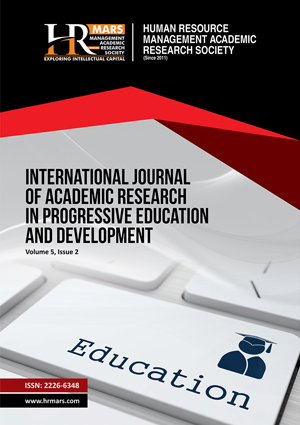Akker, J. V. D., Bannan, B., Kelly, A. E., Nieveen, N., & Plomp, T. (2013). Educational Design Research (Part A): An Introduction. Netherlands Institute for Curriculum Development: SLO. http://www.eric.ed.gov/ERICWebPortal/recordDetail?accno= EJ815766
Bhat, B. A., & Bhat, G. J. (2019). Formative and Summative Evaluation Techniques for Improvement of Learning Process. European Journal of Business and Social Sciences, 7(5), 776–785. https://ejbss.org/
Brickhouse, N. W., & Potter, J. T. (2001). Young women's science identity formation in an urban context. Journal of Research in Science Teaching, 38(8), 965–980. https://doi.org/10.1002/tea.1041
Carlone, H. B., & Johnson, A. (2007). Understanding the science experiences of successful women of color: Science identity as an analytic lens. Journal of Research in Science Teaching, 44(8), 1187–1218. https://doi.org/10.1002/tea.20237
Chen, S., & Wei, B. (2022). Development and Validation of an Instrument to Measure High School Students' Science Identity in Science Learning. Research in Science Education, 52(1), 111–126. https://doi.org/10.1007/s11165-020-09932-y
Childers, G., & Jones, M. G. (2017). Learning from a distance: high school students' perceptions of virtual presence, motivation, and science identity during a remote microscopy investigation. International Journal of Science Education, 39(3), 257–273. https://doi.org/10.1080/09500693.2016.1278483
Cole, S. E. (2012). The development of science identity: An evaluation of youth development programs at the Museum of Science and Industry, Chicago (Doctoral Dissertation, Loyola University Chicago).
Davis, S. N., & Wagner, S. E. (2014). Research Motivations and Undergraduate Researchers' Disciplinary Identity. Boletín de Filología, 49(1), 269–273. https://doi.org/10.4067/s0718-93032014000100017
De Souza, R. R., Toebe, M., Mello, A. C., & Bittencourt, K. C. (2023). Sample size and Shapiro-Wilk test: An analysis for soybean grain yield. European Journal of Agronomy, 142, 126666.
De Fillippi, R. J. (2001). Introduction: Project-based Learning, reflective practices and Learning. Management learning, 32(1), 5-10.
Fraser, J., & Ward, P. (2009). ISE Professionals Knowledge and Attitudes Regarding Science Identity for Learners in Informal Environments: Results of a National Survey (ILI Report #091104, Institute for Learning Innovation).
Frunza, V. (2014). Advantages and Barriers of Formative Assessment in the Teaching-learning Activity. Procedia - Social and Behavioral Sciences, 114, 452–455. https://doi.org/10.1016/j.sbspro.2013.12.728
Gastwirth, J. L., Gel, Y. R., & Miao, W. (2009). The Impact of Levene's Test of Equality of Variances on Statistical Theory and Practice. Statistical Science, 24(3), 343–360. https://doi.org/10.1214/09-STS301
Gatignon, H. (2013). Statistical Analysis of Management Data. (3rd ed., Vol. 1). Boston, MA: Kluwer Academic Publishers. https://doi.org/10.1007/978-1-4614-8594-0
Hac?ömero?lu, G., & Çanakkale, A. (2020). The Reliability and Validity Study of the STEM Identity Instrument. Fall 2020 Osmangazi Journal of Educational Research, 7(2), 1–13.
Hanusz, Z., & Tarasi?ska, J. (2014). Simulation study on improved shapiro-wilk tests for normality. Communications in Statistics: Simulation and Computation, 43(9), 2093–2105. https://doi.org/10.1080/03610918.2013.844835
Hasanah, U. (2020). Key Definitions of STEM Education: Literature Review. Interdisciplinary Journal of Environmental and Science Education, 16(3), e2217. https://doi.org/10.29333/ijese/8336
Hazari, Z., Sonnert, G., Sadler, P. M., & Shanahan, M. C. (2010). Connecting high school physics experiences, outcome expectations, physics identity, and physics career choice: A gender study. Journal of Research in Science Teaching, 47(8), 978–1003. https://doi.org/10.1002/tea.20363
Kim, T. K. (2015). T test as a parametric statistic. Korean Journal of Anesthesiology, 68(6), 540–546. https://doi.org/10.4097/kjae.2015.68.6.540
Liu, S., Xu, S., Li, Q., Xiao, H., & Zhou, S. (2023). Development and validation of an instrument to assess students' science, technology, engineering, and mathematics identity. Physical Review Physics Education Research, 19(1), 10138. https://doi.org/10.1103/PhysRevPhysEducRes.19.010138
Moser, B. K., & Stevens, G. R. (1992). Homogeneity of variance in the two-sample means test. American Statistician, 46(1), 19–21. https://doi.org/10.1080/00031305.1992.10475839
Moutinho, L. (2014). Exploratory or Confirmatory Factor Analysis. In The SAGE Dictionary of Quantitative Management Research (pp. 111–116). https://doi.org/10.4135/9781446251119.n34
Newell, M. J., & Ulrich, P. N. (2022). Gains in Science Identity, Science Self-Efficacy, and Career Intent Distinguish Upper-Level CUREs from Traditional Experiences in the Classroom. Journal of Microbiology & Biology Education, 23(3). https://doi.org/10.1128/jmbe.00051-22
Perkins, H. L., Bahnson, M., Tsugawa-Nieves, M. A., Kirn, A., & Cass, C. (2018). Development and testing of an instrument to understand engineering doctoral students' identities and motivations. ASEE Annual Conference and Exposition, Conference Proceedings, 2018-June. https://doi.org/10.18260/1-2--30319
Pfeifer, M. A., Zajic, C. J., Isaacs, J. M., Erickson, O. A., & Dolan, E. L. (2016). Beyond performance,competence, and recognition: Forging a science researcher identity in the context of research training. Correspondencias & Análisis, 15018, 1–23.
Rasch, D., Kubinger, K. D., & Moder, K. (2011). The two-sample t test: Pre-testing its assumptions does not pay off. Statistical Papers, 52(1), 219–231. https://doi.org/10.1007/s00362-009-0224-x
Royston, P. (1992). Approximating the Shapiro-Wilk W-test for non-normality. Statistics and Computing, 2, 117–119.
Scarbrough, H., Swan, J., Laurent, S., Bresnen, M., Edelman, L., & Newell, S. (2004). Project-based learning and the role of learning boundaries. Organization Studies, 25(9), 1579–1600. https://doi.org/10.1177/0170840604048001
Smith, M. E., & Brandenburg, D. C. (1991). Summative evaluation. Performance Improvement Quarterly, 4(2), 35-58.
Stratton, S. J. (2021). Population Research: Convenience Sampling Strategies. Prehospital and Disaster Medicine, 36(4), 373–374. https://doi.org/10.1017/S1049023X21000649
Tessmer, M. (1994). Formative Assessment Alternatives. In Performance Improvement Quarterly (Vol. 7, Issue 1, pp. 3–18).
Vincent-Ruz, P., & Schunn, C. D. (2018). The nature of science identity and its role as the driver of student choices. International Journal of STEM Education, 5(1). https://doi.org/10.1186/s40594-018-0140-5
Wholey, J. S. (1994). Assessing the feasibility and likely usefulness of evaluation. Jossey-Bass Publisher.
Yong, A. G., & Pearce, S. (2013). A Beginner's Guide to Factor Analysis: Focusing on Exploratory Factor Analysis. Tutorials in Quantitative Methods for Psychology, 9(2), 79–94. https://doi.org/10.20982/tqmp.09.2.p079
Yuying, A., & Mingsha, H. (2023). The Design Application of Biomaterial Gelatin. Academic Exchange, 7(5), 113–116. https://doi.org/10.20100/j.cnki.cn11-4548/ts.2023.07.005
